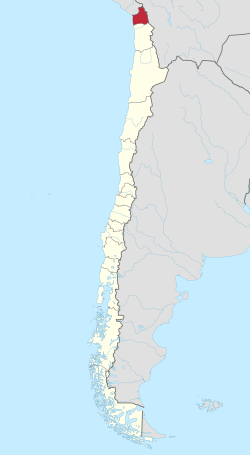Arica y Parinacota Region
The XV Arica and Parinacota Region (Spanish: XV Región de Arica y Parinacota) is one of Chile's 15 first order administrative divisions. It is the country's newest region, created under Law 20.175.[3] It became operational on 8 October 2007.
|
Región de Arica y Parinacota | |
|---|---|
 | |
Flag of Flag Coat of arms of Coat of arms | |
 Map of Arica y Parinacota Region | |
| Coordinates: 18°28′30″S 70°18′52″W / 18.47500°S 70.31444°WCoordinates: 18°28′30″S 70°18′52″W / 18.47500°S 70.31444°W | |
| Country | |
| Capital | Arica |
| Provinces | Arica, Parinacota |
| Government | |
| • Intendant | Roberto Erpel (UDI) |
| Area | |
| • Total | 16,873.3 km2 (6,514.8 sq mi) |
| • Rank | 12 |
| Highest elevation | 6,342 m (20,807 ft) |
| Lowest elevation | 0 m (0 ft) |
| Population (2017)[1] | |
| • Total | 224,548 |
| • Rank | 14 |
| • Density | 13.30789/km2 (34.46727/sq mi) |
| ISO 3166 code | CL-AP |
| HDI (2019) | 0.882[2] very high |
| Website | gorearicayparinacota |
History
Chile's former Tarapacá region was a former Peruvian province, which was occupied by Chile under the 1883 Treaty of Ancón at the close of the War of the Pacific, and then formally annexed in 1929 by the Treaty of Lima.
Geography
The Arica and Parinacota borders Peru to the north, Bolivia to the east and Chile's Tarapacá region to the south.[4]
The region is within the Norte Grande (Far North) natural region. It combines deserts, green valleys, the steep and volcanic Andes mountains, and the Altiplano (high plain) to the east. A narrow coastal strip of low-lying land no more than 2 kilometres (1 mi) wide separates the Pacific's Nazca plate from the Andes. Its Parinacota volcano is the region's highest elevation at 6,348 metres (20,827 ft) and is on the northern border with Bolivia in Lauca National Park.
The two main rivers of the region are the Lauca, which flows into the Coipasa lake in Bolivia, and the Lluta, which flows into the Pacific Ocean. Lake Chungará at 4,517 metres (14,820 ft) above sea level ranks as one of the highest in the world
Population
As of 2015, there were (estimated) 239,126 persons living in the region,[5] for a population density of 14.2 inhabitants/km².
The largest city in the region is Arica, with 210,936 inhabitants.
Administration
In 2007, the region was subdivided to create the Arica y Parinacota region and the present day Tarapacá Region to the south. The region is further subdivided into two provinces: Arica and Parinacota.
| Province | Code | Comuna | Area[4] (km²) |
Population[4] (2002) |
|---|---|---|---|---|
| Arica (151) | ||||
| 15101 | Arica | 4,799.4 | 185,268 | |
| 15102 | Camarones | 3,927.0 | 1,220 | |
| Total of the Arica province | 8,726.4 | 186,488 | ||
| Parinacota (152) | ||||
| 15201 | Putre | 5,902.5 | 1,977 | |
| 15202 | General Lagos | 2,244.4 | 1,179 | |
| Total of the Parinacota province | 8,146.9 | 3,156 | ||
Arica Y Parinacota Region Media
Chungara Lake in Lauca National Park, Chile Norte Grande and Volcan Sajama in the national park sajama Bolivia. The Lauca National Park, with a surface area of 137,883 hectares (303,342 acres) is a Global Biosphere Reserve. The Chungara Lake, one of the most elevated of the world, is located at the foot of the Payachata twin volcanoes.
Related pages
References
- ↑ 1.0 1.1 "Arica-Parinacota Region". Government of Chile Foreign Investment Committee. Retrieved 13 March 2010.[dead link]
- ↑ "Sub-national HDI – Area Database – Global Data Lab". hdi.globaldatalab.org. Retrieved 26 October 2021.
- ↑ "Ley 20175. Crea la XV Región de Arica y Parinacota y la Provincia del Tamarugal en la Región de Tarapacá". Ley Chile (in español). Valparaiso, Chile: Biblioteca del Congreso Nacional de Chile. 11 April 2007. Retrieved 3 July 2016.
- ↑ 4.0 4.1 4.2 "Región de Arica y Parinacota" (PDF). Instituto Nacional de Estadísticas. Archived from the original (PDF) on 26 June 2016. Retrieved 3 July 2016.
- ↑ "Población país y regiones - Actualización 2002-2012 y Proyección 2013-2020" (XLS) (in español). Instituto Nacional de Estadísticas (INE). 4 September 2014. Retrieved 3 July 2016.
Other websites
| Wikimedia Commons has media related to Lua error in Module:Commons_link at line 62: attempt to index field 'wikibase' (a nil value).. |
- Territorial division of Chile (in Spanish)
- Official website of the Local Government (in Spanish)
- Arica Region (in Spanish)
| Regions of Chile | |
|---|---|
| Arica y Parinacota | Tarapacá | Antofagasta | Atacama | Coquimbo | Valparaíso | O'Higgins | Maule | Ñuble | Bío Bío | La Araucanía | Los Ríos | Los Lagos | Aysén | Magallanes y la Antártica Chilena | RM Santiago | |


